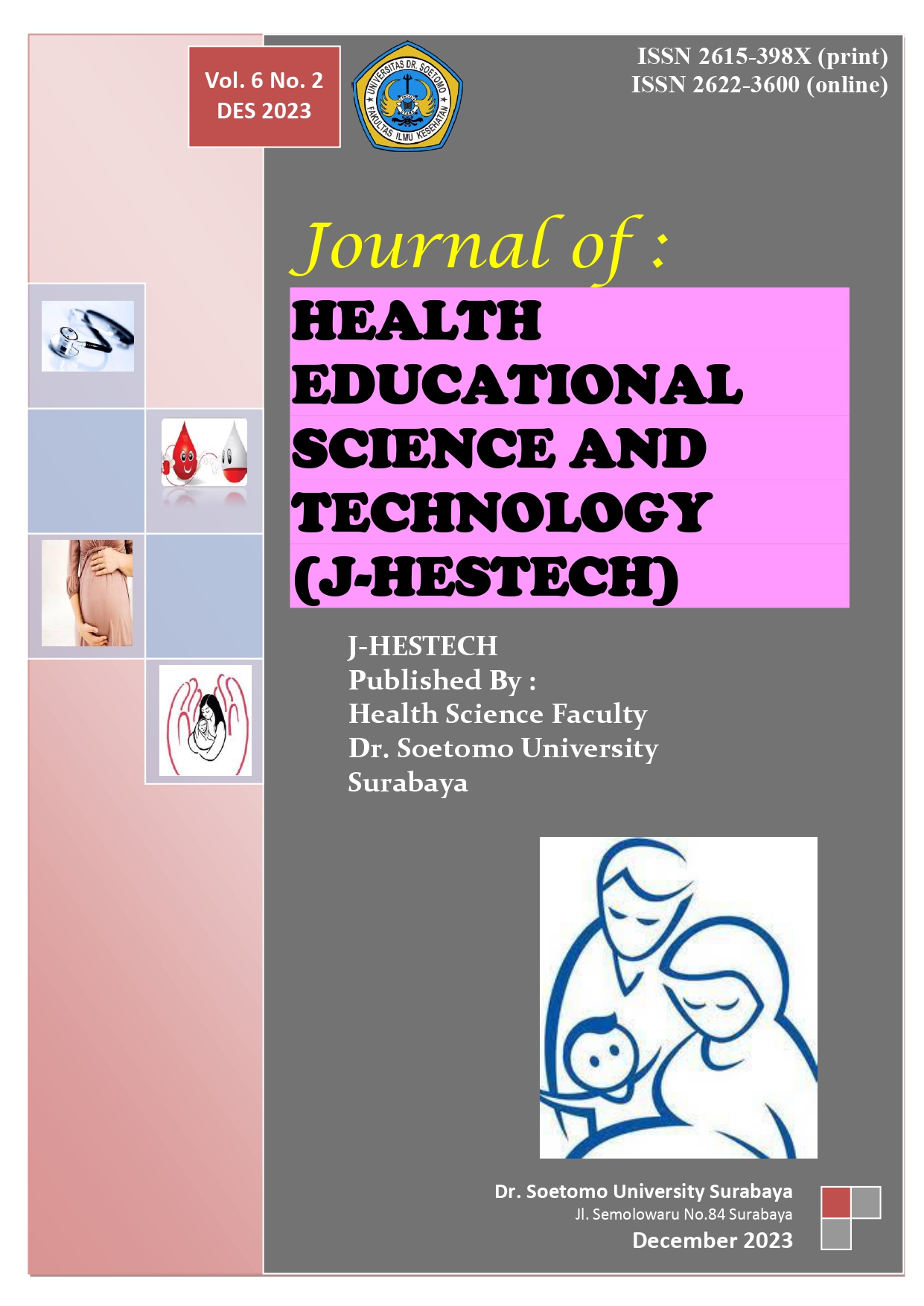Fenomena Konsumsi Sayur Dan Buah Pada Anak Usia 6-9 Tahun
 Abstract views: 483
,
Abstract views: 483
,
 PDF downloads: 1020
PDF downloads: 1020
Abstract
Abstrak Konsumsi sayur dan buah bagi anak penting untuk menunjang pertumbuhan dan perkembangan serta meningkatkan kekebalan tubuhnya. Menurut Riskesdas 2018, di Indonesia, usia 6-9 tahun merupakan kelompok umur dengan persentase konsumsi sayur dan buah tertinggi sebesar 96,9% yang dipengaruhi oleh banyak faktor. Penelitian ini bertujuan untuk mengetahui faktor-faktor yang berhubungan dengan konsumsi sayur dan buah pada anak usia 6-9 tahun di Puskesmas Simpang Tonang Kabupaten Pasaman Tahun 2021. Jenis penelitian ini adalah penelitian cross sectional. Sampel penelitian adalah 63 ibu anak usia 6-9 tahun. Mereka dipilih dengan menggunakan Proportionate Stratified Random Sampling. Instrumen penelitian berupa kuesioner dan FFQ (Food Frequency Questionnaire) kuantitatif. Kemudian data dianalisis dengan uji chi-square dengan taraf signifikansi = 0,05. Hasil penelitian menunjukkan distribusi frekuensi pendidikan ibu tinggi sebanyak 36 orang (42,9%), pendapatan keluarga tinggi 8 orang (12,7%), pengetahuan ibu baik 37 orang (58,7%), sayur dan buah kesukaan 31 orang ( 49,2%), tersedia sayur dan buah 44 orang (69,8%), pernah terpapar media massa 51 orang (81%), praktik pengendalian konsumsi sayur dan buah yang baik 32 orang (50,8%), konsumsi cukup sayur dan buah 27 orang (42,9%). Secara singkat dapat disimpulkan bahwa pengetahuan ibu merupakan variabel risiko konsumsi sayur dan buah pada anak usia 6-9 tahun. Oleh karena itu perlu peningkatan pengetahuan ibu-ibu melalui kegiatan penyuluhan dan sosialisasi.
Kata Kunci: Konsumsi Sayur dan Buah, Anak Usia 6-9 Tahun
Abstract Vegetable and fruit Consumption for children is important to support growth and development and increase their immunity. According to Riskesdas 2018, in Indonesia, the age of 6-9 years was the age group with the highest percentage of consumption of vegetables and fruit at 96.9% which is influenced by many factors. This research aimed to determine Factors Related to Vegetable and Fruit Consumption among Children 6-9 Years Old in Simpang Tonang Community Health Center, Pasaman Regency in 2021. The type of this research was a cross-sectional study design. The samples were 63 children’s mothers at 6-9 years. They had been chosen by using Proportionate Stratified Random Sampling. The research instruments were questionnaires and quantitative FFQ (Food Frequency Questionnaire). Then, the data were analyzed by chi-square test with a significance level of = 0.05. The results of the research showed the distribution of high maternal education frequency as many as 36 people (42.9%), high family income 8 people (12.7%), good mother knowledge 37 people (58.7%), favorite vegetables and fruits 31 people (49.2%), there are available vegetables and fruit 44 people (69.8%), have been exposed to mass media 51 people (81%), good practice of controlling the consumption of vegetables and fruit 32 people (50.8%), sufficient consumption of vegetables and fruit 27 people (42.9%). In short, it can be concluded that mothers’ knowledge was a risk variable for consuming vegetables and fruit for children at 6-9 years old. Therefore, it needs to increase mothers’ knowledge through outreach and socialization activities.
Keywords: Consumption of Vegetables and Fruits, Children 6-9 Years Old
References
Agnes Sevelina Anggraeni, Tintin Sukartini, Kristiawati. 2017. “CONSUMPTION OF FRUIT AND VEGETABLE WITH RISK OF OBESITY IN SCHOOL-AGE CHILDREN.†Jurnal Ners.
Angraeni, Nur Asih, and Trini Sudiarti. 2018. “Faktor Dominan Konsumsi Buah Dan Sayur Pada Remaja Di SMPN 98 Jakarta.†Indonesian Journal of Human Nutrition 5(1):18–32.
Bassul, Carolina, Clare A. Corish, and John M. Kearney. 2020. “Associations Between The Home Environment, Feeding Practices and Children s Intakes of Fruit, Vegetables, and Confectionary / Sugar-Sweetened Beverages.†International Journal Of Environmental Research and Public Health 17:1–21.
Folkvord, Frans, and Manouk de Bruijne. 2020. “The Effect of the Promotion of Vegetables by a Social Influencer on Adolescents’ Subsequent Vegetable Intake: A Pilot Study.†International Journal of Environmental Research and Public Health 17(7). doi 10.3390/ijerph17072243.
Grimm, Kirsten A., Sonia A. Kim, Amy L. Yaroch, and Kelley S. Scanlon. 2014. “Fruit and Vegetable Intake during Infancy and Early Childhood.†Pediatrics 134(September 2014):S63–69. Doi: 10.1542/peds.2014-0646K.
Handini, Dian, Burhannudin Ichsan, and Dona Dewi Nirlawati. 2010. “Dengan Status Gizi Balita Di Wilayah Kerja Puskesmas Kalijambe.†Jurnal Biomedika 5(2):7–10.
Hastuti, Mona, Kintoko Rochadi, and Etti Sudaryati. 2019. PERBANDINGAN MEDIA AUDIOVISUAL DAN CERAMAH TERHADAP SIKAP SISWA TENTANG PENTINGNYA KONSUMSI SAYUR DAN BUAH. Vol. 4.
Hendriyani, Feftin, Elsa Safira Prameswari, and Agung Suharto. 2018. “Peran Vitamin C, Vitamin E Dan Tumbuhan Sebagai Antioksidan Untuk Mengurangi Penyakit Diabetes Mellitus.†Tunas- Tunas Riset Kesehatan 8(1):36–40.
Haryana, Ade. 2020. Buku Ajar Metodologi Penelitian Pada Kesehatan Masyarakat. Vol. 2.
Hurtado-Barroso, Sara, Marta Trius-Soler, Rosa M. Lamuela-Raventós, and Raul Zamora-Ros. 2020. “Vegetable and Fruit Consumption and Prognosis Among Cancer Survivors: A Systematic Review and Meta-Analysis of Cohort Studies.†Advances in Nutrition (Bethesda, Md.) 11(6):1569–82. doi 10.1093/advances/nmaa082.
Ismael, Zahraa, Murtadha Ghanim Adai, and Zainab Ali Hussein. 2020. “GSJ: Volume 8, Issue 9, September 2020, Online: ISSN 2320-9186 Relationship between Mother s Knowledge and Nutritional Status among Preschool Children .†8(9):1762–71.
Kabir, Md Ruhul, Mostafizur Rahman, Md Abdullah Al Mamun, and Homayra Islam. 2018. “Prevalence of Malnutrition and Associated Factors Affecting the Nutritional Status of Adivasi (Tribal) Children Aged 24-59 Months in Bangladesh.†Asian Journal of Medical and Biological Research 4(2):178–85. doi: 10.3329/ajmbr.v4i2.38253.
Keeley, Brian, Editor Chief, Céline Little, Kasper Vrolijk, Data Analyst, Samantha Wauchope, Production Specialist, Ahmed Al, Izzi Alnaqshbandi, Arabic Editor, Carlos Perellon, Spanish Editor, Alix Reboul-, Upasana Young, Fabrice Declerck, Alessandro Demaio, Jody Harris, Jenna Hollis, Karen Mccoll, Melissa Munn-Chernoff, Nicholas Nisbett, Michael N. Onah, Mimi Tatlow- golden, Dylan Walters, Jessica Fanzo, Lawrence Haddad, Purnima Menon, Roland Kupka, Joan Matji, David Matern, and Christiane Rudert. 2019. Children, Food and Nutrition.
Lee, Wee Chee., Siti Safiah. Mokhtar, Seetha. Munisary, Sahran. Yahaya, and Aida Hanum Ghulam. Rasool. 2018. “Vitamin D Status and Oxidative Stress In Diabetes Mellitus.†Cellular and Molecular Biology 64(7):60–69.
Leo, Agnes A. Rihi, Willa, Sry M.Ch, Bilaut, Deby Anita. 2020. “Hubungan Konsumsi Laru, Garam, Sayur, Dan Buah Terhadap Resiko Hipertensi Pria Dewasa Kupang.†Jurnal Ilmiah Gizi Kesehatan 1(02):1–9.
Mardhiah, D., I. Ekayanti, and B. Setiawan. 2019. “The Relationship Between Mother’s Nutritional Knowledge Towards Fruits Vegetables Consumption and Nutritional Status of Pre School Children Kindergarten Salman Jakarta.†KnE Life Sciences 4(10):47. doi: 10.18502/kls.v4i10.3706.
Muniroh, Lailatul. 2015. “Hubungan Tingkat Pendidikan, Tingkat Pengetahuan Dan Pola Asuh Ibu Dengan.†Media Gizi Indonesia 10(1):84–90.
Nekitsing, Chandani, Marion M. Hetherington, and Pam Blundell-Birtill. 2018. “Developing Healthy Food Preferences in Preschool Children Through Taste Exposure, Sensory Learning, and Nutrition Education.†Current Obesity Reports 7(1):60–67. doi: 10.1007/s13679-018-0297
Numaliza, Numaliza, and Sara Herlina. 2018. “Hubungan Pengetahuan Dan Pendidikan Ibu Terhadap Status Gizi Balita.†KESMARS: Jurnal Kesehatan Masyarakat, Manajemen Dan Administrasi Rumah Sakit 1(1):44–48. doi: 10.31539/kesmars.v1i1.171.
Nurtiana, Winda, Slamet Budijanto, and Lilis Nuraida. 2018. “Bekatul Beras Sebagai Pencegah Kanker Kolon Rice Bran For Preventing Colorectal Cancer.†Jurnal Pangan.
Peltzer, Karl, and Supa Pengpid. 2012. “Fruits and Vegetable Consumption and Associated Factors among In-School Adolescents in Five Southeast Asian Countries.†International Journal of Environmental Research and Public Health 9(10):3575–87. doi 10.3390/ijerph9103575.
Persky, Susan, Rebecca A. Ferrer, William M. P. Klein, Megan R. Goldring, Rachel W. Cohen, William D. Kistler, Haley E. Yaremych, and Sofia Bouhlal. 2019. “Effects of Fruit and Vegetable Feeding Messages on Mothers and Fathers: Interactions between Emotional State and Health Message Framing.†Annals of Behavioral Medicine 53(9):789–800. doi: 10.1093/abm/kay088.
Poirier, Abbey E., Yibing Ruan, Lauren A. Hebert, Xin Grevers, Stephen D. Walter, Paul J. Villeneuve, Darren R. Brenner, and Christine M. Friedenreich. 2019. “Estimates of the Current and Future Burden of Cancer Attributable to Low Fruit and Vegetable Consumption in Canada.â€Preventive Medicine 122:20–30. doi: 10.1016/j.ypmed.2019.03.013.
Scaglioni, Silvia, Valentina De Cosmi, Valentina Ciappolino, Fabio Parazzini, Paolo Brambilla, and Carlo Agostoni. 2018. “Factors Influencing Children’s Eating Behaviours.†Nutrients 10(6):1– 17. doi: 10.3390/nu10060706.
Seidu, Abdul-Aziz, Richard Gyan Aboagye, James Boadu Frimpong, Hawa Iddrisu, Ebenezer Agbaglo, Eugene Budu, John Elvis Hagan, and Bright Opoku Ahinkorah. 2021. “Determinants of Fruits and Vegetable Consumption among In-School Adolescents in Ghana.†Adolescents 1(2):199–211. doi: 10.3390/adolescents1020016














